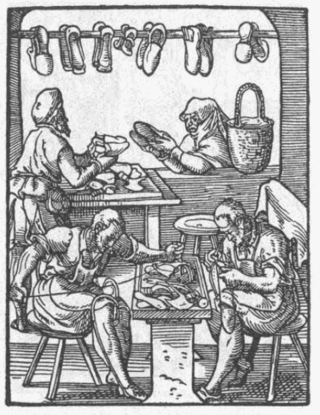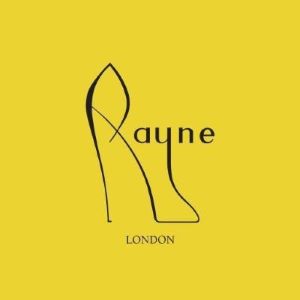Related Research Articles
Antony Price is an English fashion designer best known for evening wear and suits, and for being as much an "image-maker" as a designer. He has collaborated with a number of high-profile musicians, including David Bowie, Robert Palmer, Iva Davies, Steve Strange, and Duran Duran, but especially Bryan Ferry and Roxy Music, whose look was defined by Price's designs. The manner in which Price dressed – or in many cases, undressed – the "Roxy girls" on the covers of their albums helped to define the band's pop retro-futurism.

Shoemaking is the process of making footwear.

Biba was a London fashion store of the 1960s and 1970s. Biba was started and run by the Polish-born Barbara Hulanicki and her husband Stephen Fitz-Simon.

Manuel "Manolo" Blahnik Rodríguez is a Spanish fashion designer and founder of the eponymous high-end shoe brand.

Chelsea boots are close-fitting, ankle-length boots with elastic side panels, a low heel and a snug fit around the ankle. They often have a loop or tab of fabric on the back of the boot, enabling the boot to be pulled on. The boot dates back to the Victorian era, when it was worn by both men and women.
Susan Bennis/Warren Edwards was a successful New York-based shoe company founded in 1972 by Susan Bennis and Warren Edwards. It dissolved in 1997.

Ballet flats or ballet pumps are a style of shoe. The appearance is inspired by women's ballet shoes, with a very thin heel or the appearance of no heel at all. The style sometimes features a ribbon-like binding around the low tops of the slipper and may have a slight gathering at the top-front of the vamp or a small, decorative string tie.

Mr Freedom was a clothing boutique in London which sold fashion by a number of young designers commissioned by the owner, designer Tommy Roberts, and his partner, Trevor Myles. Celebrities such as Freddie Mercury and Elton John wore designs from the shop which was at 430 King's Road in Chelsea, London from 1969–70 and then at 20 Kensington Church Street in Kensington.
Terrence Higgins, professionally known as Terry de Havilland, was an English shoe designer. Known as the 'Rock n Roll Cobbler of the 1970s', he is most famed for his key part in the ‘Swinging London’ fashion scene, with clients including Marianne Faithfull, Led Zeppelin, Bianca Jagger and David Bowie. His platforms are still worn today by British model Kate Moss.
Clive Evans, better known as Clive, was a London-born fashion designer of the 1960s who attracted a number of celebrity fans and was promoted internationally as a high fashion designer from Swinging London.
Christopher McDonnell is a British fashion designer who operated in the UK between the 1960s and 1980s. In the US, he was known under his own name, and in the UK he operated under the brand name Marrian-McDonnell before switching to an eponymous label in 1973.
Stirling Cooper was a London-based fashion wholesaler and retailer that, along with brands such as Biba, Quorum, Browns and Clobber, helped to redefine UK fashion in the late 1960s.

Prudence Loveday Glynn, Baroness Windlesham, was a British fashion journalist and author, best known for her long-running role as the first fashion editor of The Times.

Sir Edward Rayne was head of H. & M. Rayne, one of the foremost British manufacturers of high-end and couture shoes. With a Royal Warrant to both the Queen and Queen Mother, Rayne shoes were worn by high society and film stars.

Rayne was a British manufacturer known for high-end and couture shoes. Founded in 1899 as a theatrical costumier, it diversified into fashion shoes in the 1920s.
Workers for Freedom was a British fashion label that was launched in 1985 by Graham Fraser and Richard Nott. The brand was awarded Designer of the Year in 1989 at the British Fashion Awards.
Moya Bowler is an English shoe designer who rose to prominence in the 1960s. She had considerable success in both the UK and US fashion markets, designing both high-end and high-street shoes.
Sheilagh Brown is a British fashion designer who began her career in the 1960s, as part of the Swinging London scene. She was among the designers for Stirling Cooper, working subsequently at Coopers and Quorum, before establishing the label Barnett and Brown with Sheridan Barnett.
Women's Home Industries was a company founded in 1947 in London to earn export revenue for the UK in the post-war period by harnessing women's craft skills, such as knitting and needlework.
Lawrence Gavin Bertran Robinson was a South African model agent in London's Old Bond Street in the 1960s and 70s who was part of the Swinging London scene. His show at Mare Moda in Capri in 1969 was described by The Times as "as zippy, as nippy and as hippy as anything seen in London's West End", while a show for Harrods in 1970 was noted for his technique of making his models move to music like machines.
References
- 1 2 King-Deacon, Antony (26 April 1968). "Men's fashion by Antony King-Deacon". The Times. No. 57236.
- ↑ Lumsden, Andrew (12 November 1969). "Which path for shoemakers?". The Times. No. 57715.
- ↑ Glynn, Prudence (12 August 1969). "That's shoe business". The Times. No. 57636.
- ↑ Deacon-Smith, Antony (24 October 1969). "Men's Fashion". The Times. No. 57699.
- ↑ Walker, Mirabel (17 July 1969). "Glorious Jumble". The Guardian.
- 1 2 "Dress of the Year". fashionmuseum.co.uk. Fashion Museum, Bath. Retrieved 3 June 2015.
- ↑ "Paint your own boots". The Times. No. 57840. 10 April 1970.
- ↑ Glynn, Prudence (20 October 1970). "Fashion by Prudence Glynn". The Times. No. 58001.
- ↑ Glynn, Prudence (30 March 1971). "Brittania Crosses the Waves". The Times. No. 58134.
- ↑ Glynn, Prudence (24 August 1971). "Coming Attractions". The Times. No. 58258.
- ↑ Schiro, Anne-Marie (16 March 1980). "Fit. Comfort Most Important . These Shoe Designers Sell, And Wear Their Shoes". Daytona Beach Sunday News-Journal. Retrieved 19 February 2014.
- 1 2 "Picture Page". The Times. No. 58914. 16 October 1973.
- ↑ Glynn, Prudence (30 March 1976). "Shopping". The Times. No. 59666.
- ↑ "Hot on the Heel of Fashion (advert)". The Guardian. 23 June 1978.
- ↑ "Bids & Deals". The Guardian. 3 January 1979.
- ↑ Cunningham, Sarah (25 June 1997). "Americans step into UK shoes". The Times. No. 65925.
- ↑ Buckley, Sophy (10 November 2004). "Baugur set to increase footprint on high street". Financial Times. Retrieved 4 July 2015.
- ↑ "Shopping Basket: What Baugur Owns in the UK". The Times. No. 69293. 9 April 2008.
- ↑ Brown, Jessica (3 March 2009). "Shoe Studio Group sold to Dune". Drapers. Retrieved 4 July 2015.
- ↑ Ryan, John (5 December 2009). "Chelsea Cobbler, Mayfair, London". Drapers. Retrieved 3 July 2015.
- ↑ "Dune opens Chelsea Cobbler". WJ London. 8 March 2012. Retrieved 3 July 2015.